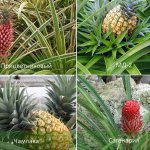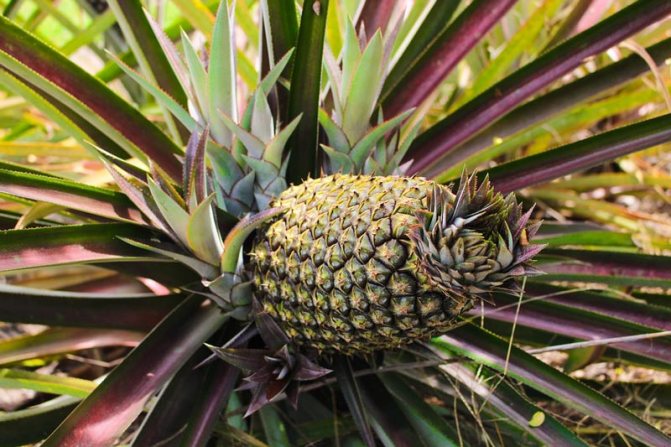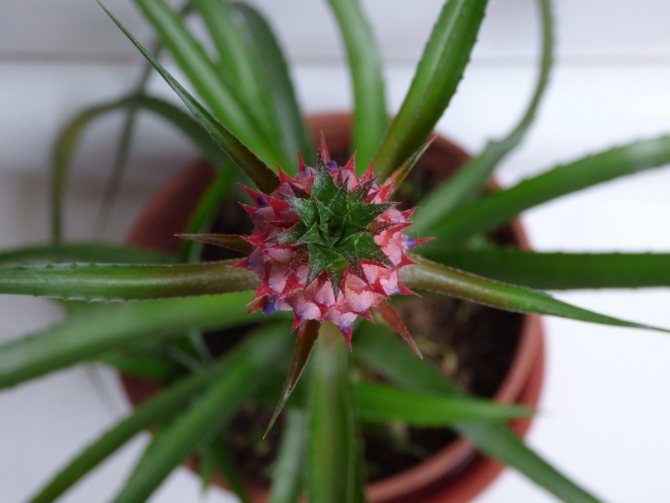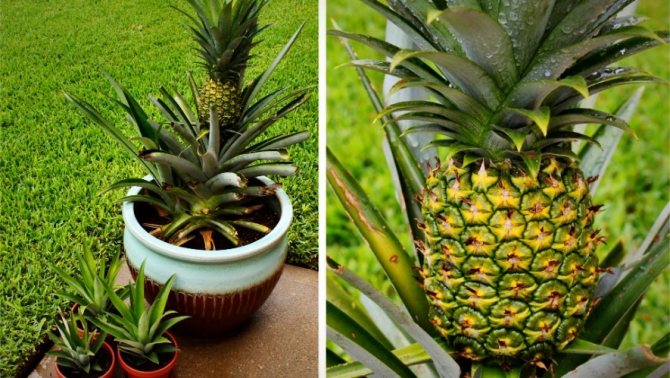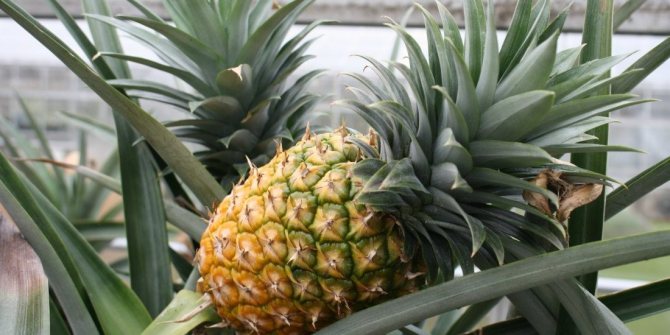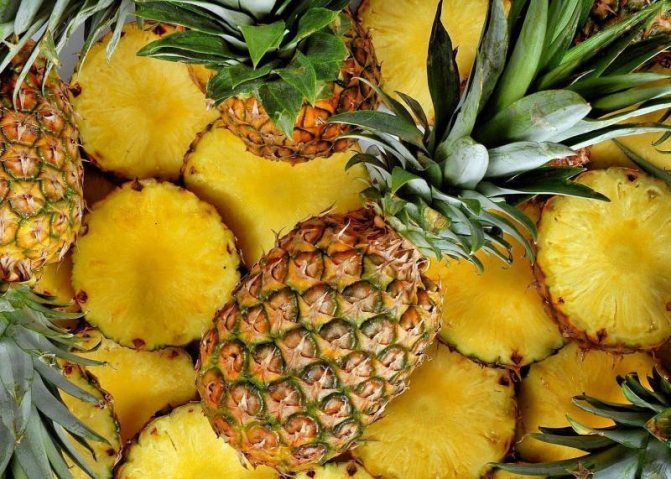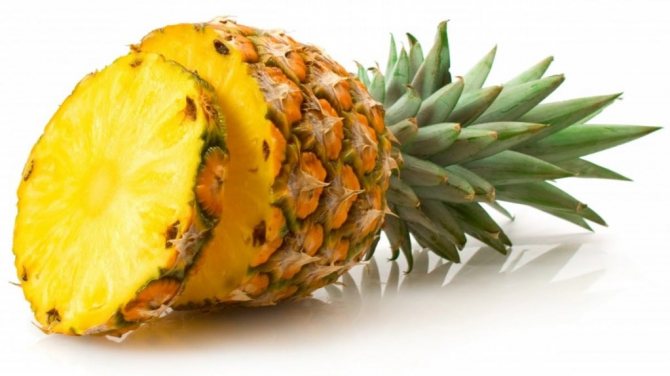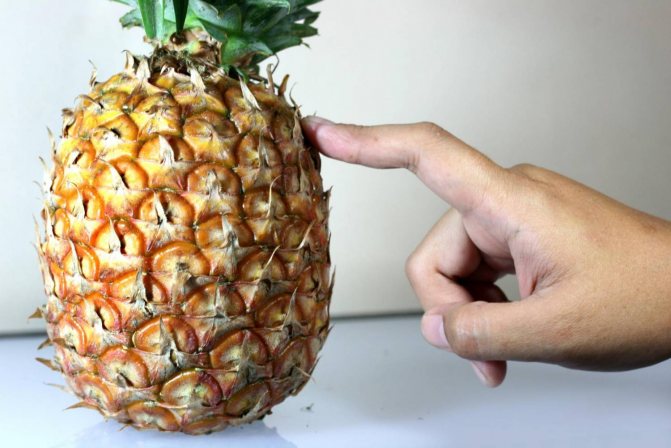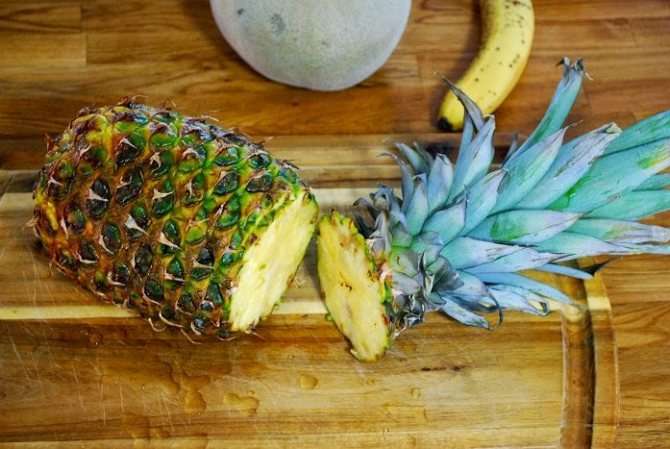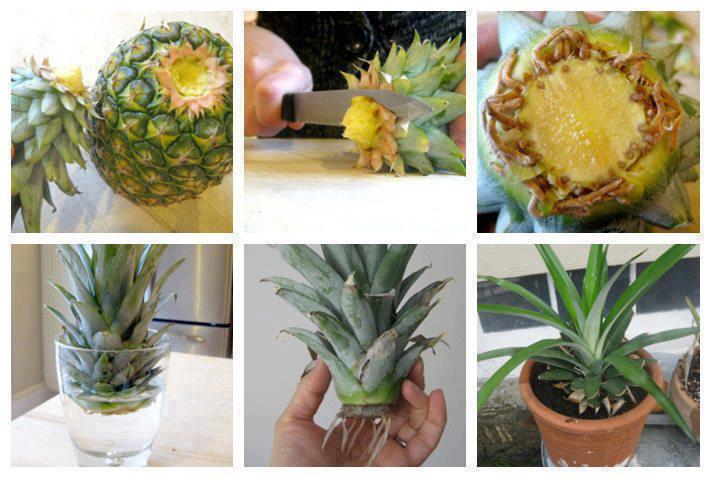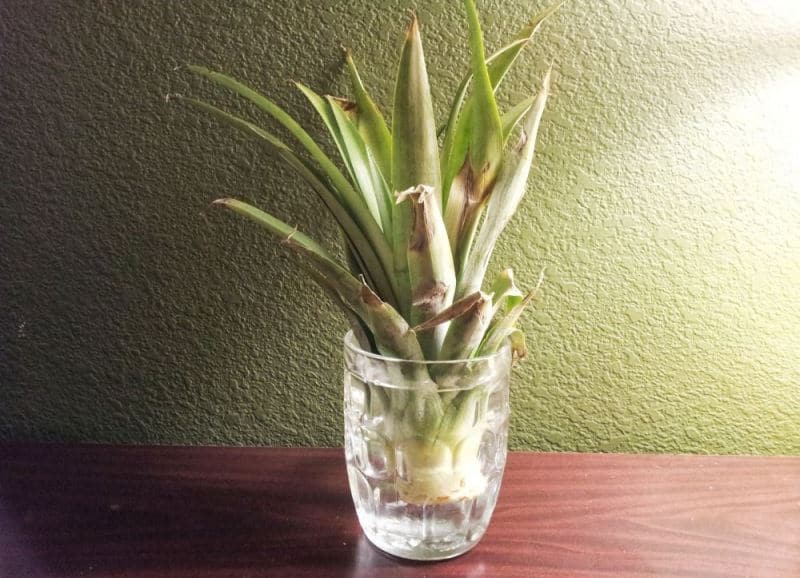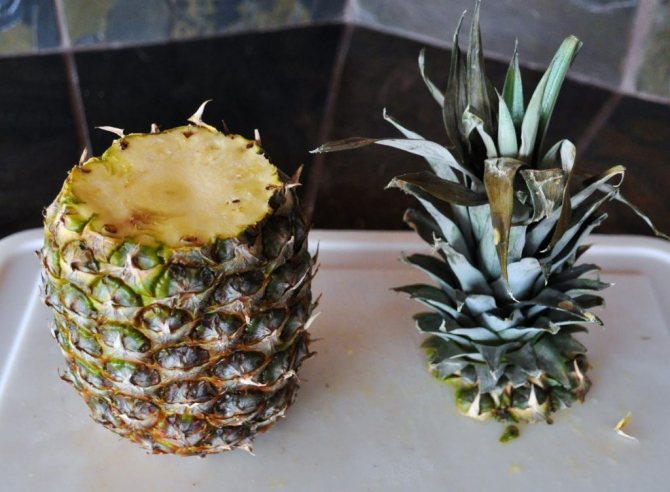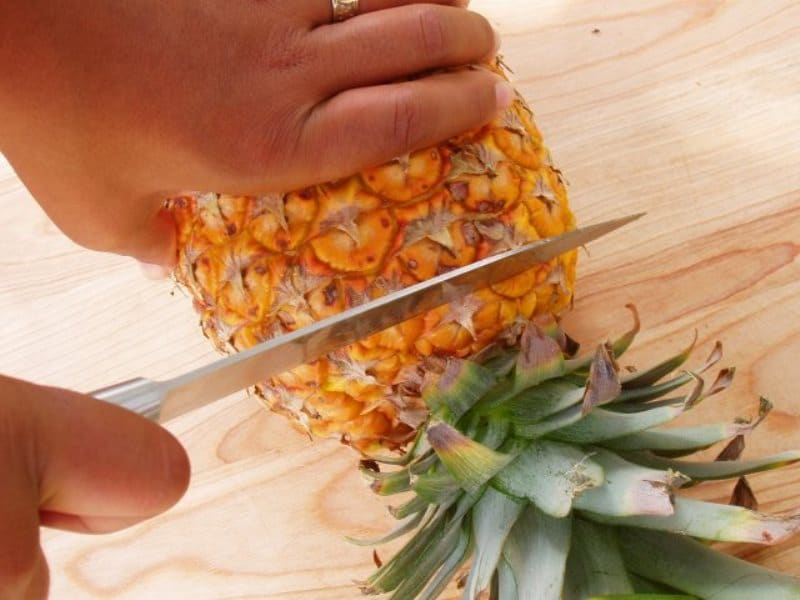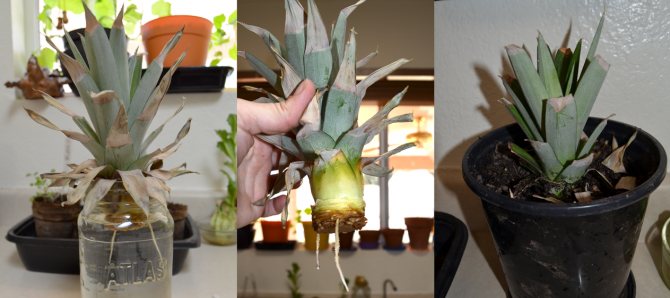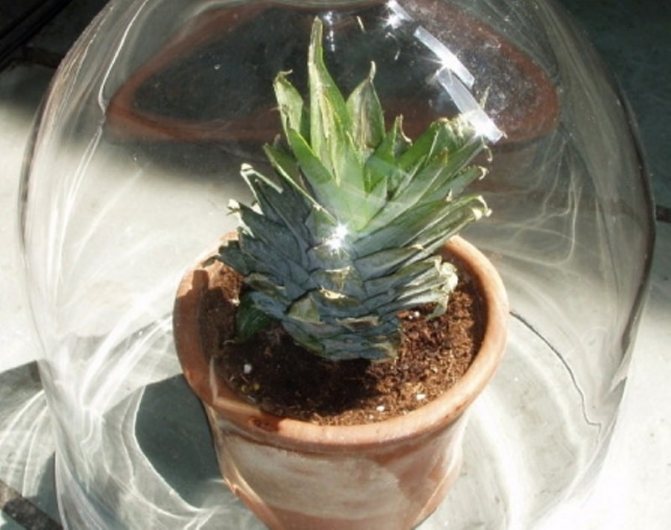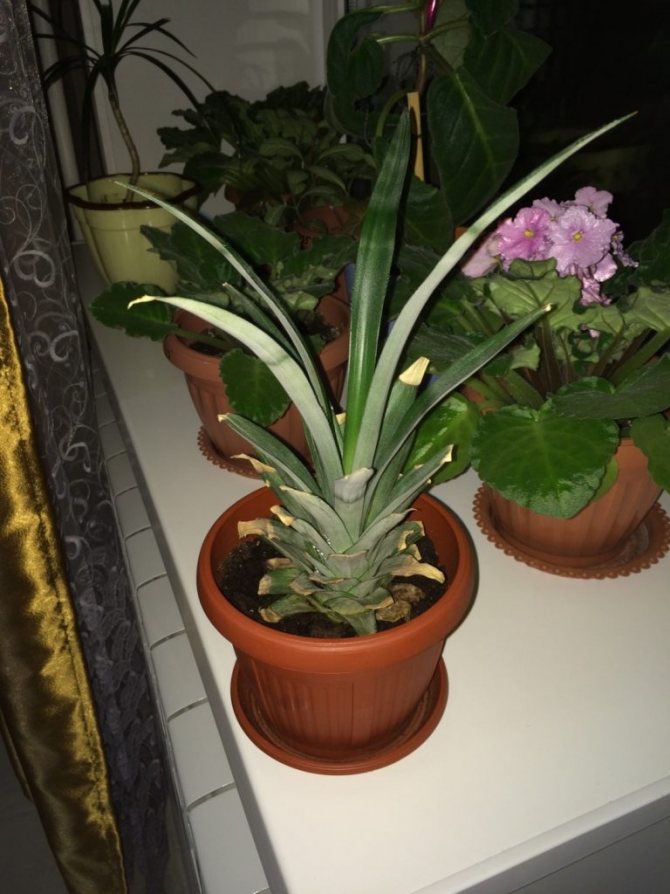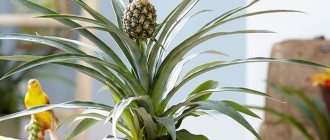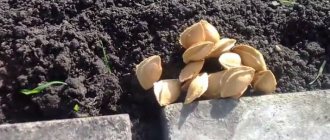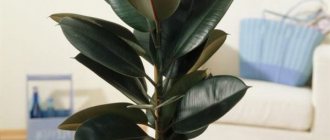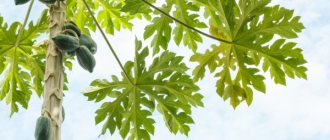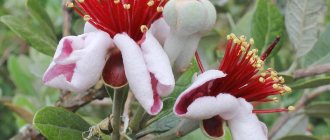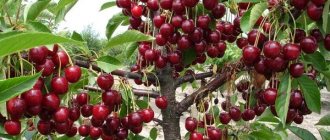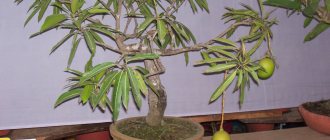Category: Houseplants
Pineapple has not only a pleasant taste, but also a significant number of useful properties. There is an opinion that this fruit contains all minerals and vitamins. It is not surprising that many have a desire to grow it on their own. But not everyone decides on such an experiment due to the tropical origin of the fruit. If you still decide to grow pineapple from the top of the house, then read the planting rules and care recommendations.
- Required tools and materials
- Step-by-step instructions for growing pineapple from the top
The choice of planting material
- Top preparation
- Video: apex preparation technique
- Landing
- Temperature
Description of pineapple
Pineapple is a perennial; during the growing season it forms dense fleshy leaves, collected by a rosette. Its leaves are succulents, they are able to accumulate moisture in tissues. The length is from 30 to 100 cm. A dense, massive stem grows from the root rosette. The peduncle is formed at the apex, up to 50 cm long. The flowers are spicate; when ripe, a rosette with bracts appears at the apex. The flowering period of an adult plant, 3-4 years old, occurs from May to July. Fruits weighing up to 5 kg, juicy, sweet and sour, look like a large golden coniferous cone with a bunch of short leaves at the top. The root system is weak, 30 cm deep.
Growing pineapple - step by step, instructions with photos and videos
To grow this beautiful plant with a tasty fruit on your own, first of all, you should buy the fruit along with a rosette of leaves located on the top of the fruit. This outlet is relatively easy to root. We will explain below how to do this, starting with the purchase of the fruit.
Buying fruit
First you need to choose the right pineapple in the store. It should be noted whether it has a full rosette of leaves along with the center. It is important to choose the fruit that is ripe and healthy, with beautifully colored green leaves. The plant should not have a brown top. A flower sprout should protrude from the outlet - this will give us a guarantee that the plant will bloom.
How to root properly?
To germinate the roots, it is important to properly prepare the tail for planting so that the plant grows roots. First, cut off the rosette of leaves at the top, leaving 1-2 cm of fruit near the outlet, a photo of the correct cut is shown below.
A fragment of the fruit must be peeled with a knife in the form of a slightly rounded heel. Then we cut off the remnants of the pulp with a knife so that the fibrous part remains. It is important to remove all the pulp when preparing the seedlings, otherwise it will start to rot. If white dots are visible on the cut, these are root nodules; it is advisable not to damage them during cleaning.
Growing fruit from their tail, photo
Leaves should be torn off from the bottom of the outlet in an area of about 2 cm. To avoid damage to the roots sprouting from under the leaves, clean the trunk from the leaves, tearing them off perpendicular to the trunk. On some pineapples, after removing the leaves, already at this stage we can see small sprouted roots.
Germination and planting
The planting material obtained in this way is soaked in water to half a fragment of torn leaves. After about 1-2 weeks, they start to take root. When the roots are several centimeters long, remove the seedling from the water and place it on a paper towel. Let it dry for 2-3 hours. After drying, the seedlings are planted in soil intended for growing palm trees. The soil in the pot should not be too wet, but only slightly damp. It is necessary to bury the entire section of the stem without leaves in the ground.
Growing pineapple - video
Of course, our little palm tree needs proper care.
- Pot for this exotic plant, it should be large enough so that after planting the seedlings, about 2 cm of soil remains around the plant to the edge. Usually pots with a diameter of 12 to 14 centimeters are suitable. When new leaves appear in the center of the rosette, it means that a well-rooted plant is starting to grow. After that, you should put the pot in the sunniest place in the apartment. Pineapple is transplanted once a year, it is better to do this in early summer. It is imperative to select the diameter of the pot so that it is about 2 cm from the plant to its edge.
- The soil: It is easy to buy special soil made for palm trees in garden stores. The plant is quite tolerant of the ground, so a universal soil can also be used. A drainage layer should be created at the bottom of the pot to minimize the risk of flooding and thereby reduce the risk of root rot. This soil is fertile enough for pineapple, so it does not require additional feeding.
- Bloom: The first flowers begin to appear about 1.5-2 years after planting. In very sunny places, fruits develop from flowers.
- Temperature:pineapples feel comfortable at room temperature - 25 ° C in summer and 20 ° C in winter.
- Watering: the seedling does not need constantly moist soil. In summer, pineapple grown in pots is watered 2-3 times a week, in the cold season at a temperature of about 20 degrees, the plant should be watered no more than once a week. Water can be poured into the socket. Before watering, tap water should be prepared - filtered or at least defended so that it does not contain harmful salts and chlorine. The plant loves regular spraying.
Features and types of homemade pineapple
Under natural conditions, the plant reaches a meter in height, with a diameter of two meters. The room grows only up to 70 cm. Adapted species:
| View | Features of the |
| Bracts | Leaves are one meter long, curved, bright green, on the surface of their white, yellow stripes. When they fade in the sun, they turn pink, red. The tricolor look is popular in indoor floriculture. |
| Large-crested | Linear leaves grow up to a meter, are arranged in a spiral, form a spike-shaped inflorescence. The color of the flowers is purple, pink, red. |
| Dwarf | Dark green, narrow leaves, serrated at the edges, pointed at the end up to 30 cm. For decorative cultivation only. |
| Shiny (black) | Long dark leaves at the edges with red, brown, bright green shades in the middle. |
| Champaka | Sharp, serrated leaves with conical pink inflorescences. |
| Decorative | Beautiful outwardly with bright bracts and variegated leaves of red shades. |
| Caena | Up to 30 cm high, on a short stalk, edible fruits up to 5 kg in the form of a cylinder. Leaves are not prickly, without thorns. |
| Sagenaria | Two-meter leaves, bright red fruits. |
| MD-2 | The hybrid, with sweet tasty fruits, is resistant to diseases and pests. Distributed on shelves due to long-term storage. |
| Mauritius | Differs in excellent taste. |
Landing features: step by step
If you are at least basic familiar with floriculture, then growing a delicious and sweet fruit will not be difficult.The whole question is only in the correct organization of processes and in a long wait. But otherwise, the ripening of the fruit will not work. Here are the most important steps to follow.
- First, choose the planting material (there are several ways)
- Purchase ready-made or compose yourself the necessary soil for planting.
- Carefully care for the green top of the leaves so that it sprouts.
- Next, root the top of the fruit in the ground, following all recommendations.
- Throughout growth and development, constantly follow the rules of care.
If you follow all the recommendations and strictly follow them, then in a maximum of 3 years you will be able to taste your own homemade pineapple with a sweet characteristic magical taste and aroma.
From the top or tail
This is the easiest and most affordable way. To plant and successfully grow pineapple, you need to do the following.
- First, cut out the top with leaves and prepare it for rooting. This is stripping, treatment with growth stimulants and activated carbon against the appearance of diseases and infections, drying so that rot does not form.
- After 7 days, place the top of the plant in water and wait for the first roots to appear.
- It is important to keep warm and the absence of sunlight, to avoid drafts and sudden changes in temperature.
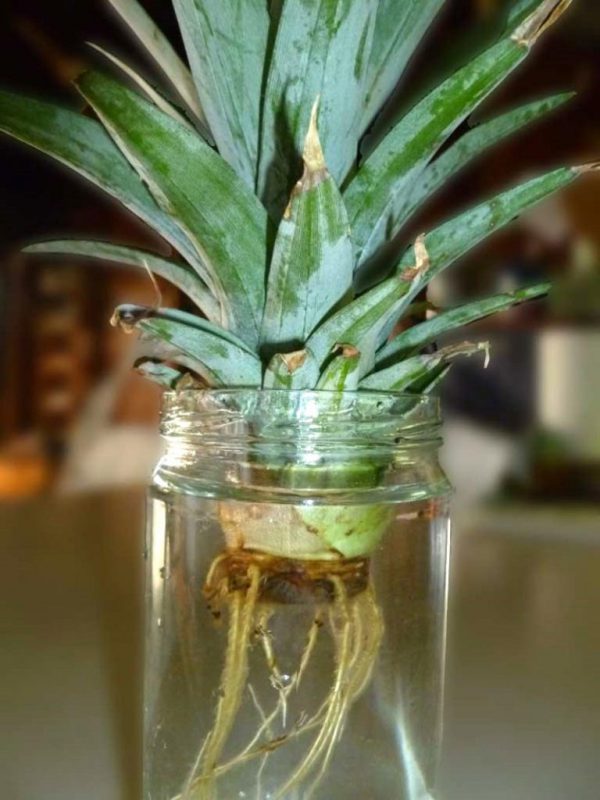
After the appearance of the roots, planting should be carried out.
Then take care of, according to agrotechnical rules and regulations.
From seed
You can also choose the seed method, but it may be difficult to find. The seeds can only be purchased in special gardening or flower shops, with a quality certificate.
Experienced flower growers advise against purchasing seeds from hands or in unverified places.
Next, the seeds must be placed in a humid environment. To improve seedling, it should be placed in the refrigerator for hardening (stratification). Then, after germination, you need to plant in the soil and wait for seedlings. Then plant and grow according to the basic plan, as well as the tops.
Selection and preparation of planting material
The easiest way to grow pineapple at home is from a crown or rosette of leaves. To plant a plant, use a ripe fruit, without signs of diseases and pests. The leaves should be green with no yellow or brown spots, and the skin should be golden brown and firm to the touch.
It is not recommended to take fruit bought in winter, preferably in summer or early autumn.
Preparation of material for planting from the top step by step:
- Carefully cut it off with a sharp knife, without touching the core, or unscrew it with a smooth rotation along the axis.
- Peel the remaining pulp with a knife.
- The lower leaves are removed.
- The cut site is treated with charcoal.
- The cut part is placed vertically to dry for two weeks.
- Subsequently, they are placed in a container with water or with prepared soil.
- Dishes with water should be dark, place the top 3-4 cm, not completely.
- After the roots have formed, they are laid on a paper towel to dry.
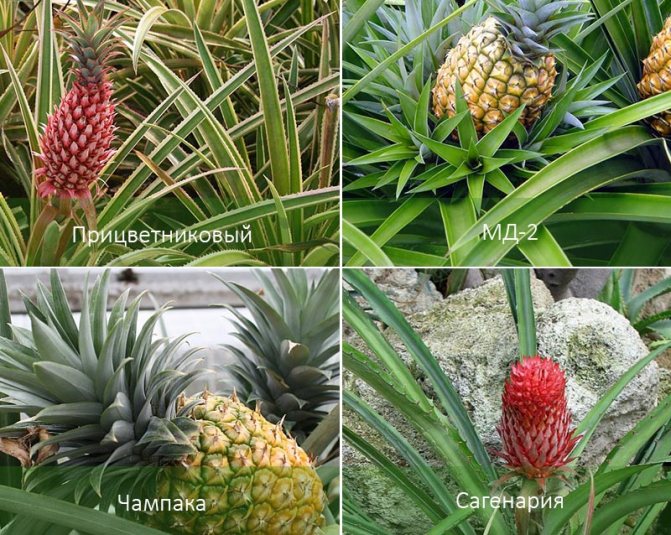

After the actions taken, they are planted in loose and nutritious soil.
Step-by-step instructions on how to grow pineapple from the top of the house
Most flower growers have tried at least once to grow a perennial herb, which is a member of the Bromeliad family. Pineapple is a crop that can be grown from the "tuft" (top).
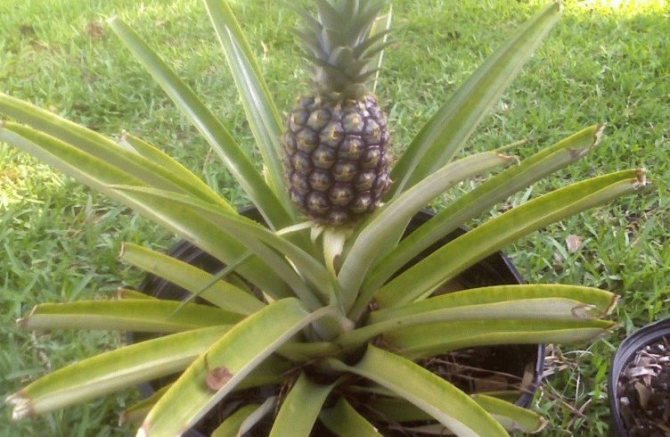

Growing pineapple from the top
To grow a fruit perennial at home, you should use:
- seed material;
- cuttings;
- the tops of the fruits.
To simplify the process, it is advisable to go to the retail network and purchase quality fruits. When choosing, you should pay attention to:
- Freshness and ripeness of the fruit. Ripe pineapple fruit will exude an amazing aroma, as strong as citrus fruits.
- No rot and damage to the fruit.Each fruit must be inspected carefully before purchasing. The presence of stains indicates damage to the fruit.
- Fruit color. What does a ripe pineapple look like? The fruit should be yellowish in color. The presence of green on the skin indicates immaturity.
- The crown color should be green. At the same time, the tips should dry out slightly. Fruits with yellow foliage are not suitable for growing, so it is best to leave them on the counter.
Note! It is necessary to buy pineapples for rooting in the summer or in September. It is during this period that it is easiest to choose fruits suitable for planting.
Preparing the crown for rooting
Before growing pineapple from the "tuft", you should do the following:
- Cut off the top of the exotic fruit. The lower foliage is pinched off.
- Remove the pulp with gentle strokes. It is important not to damage the peel when doing this.
- The cut off top must be turned over and left to dry for 4-5 days. After the specified period of time, the cut area will become more rigid.
Rooting pineapple at home
After carrying out the preparatory procedures, they start rooting the pineapple:
- The top of the exotic fruit should be placed in a container filled with water.
- The crown is left in water for 7-10 days.
- After a week, the tip should take root.
- The water must be changed daily to avoid clouding.
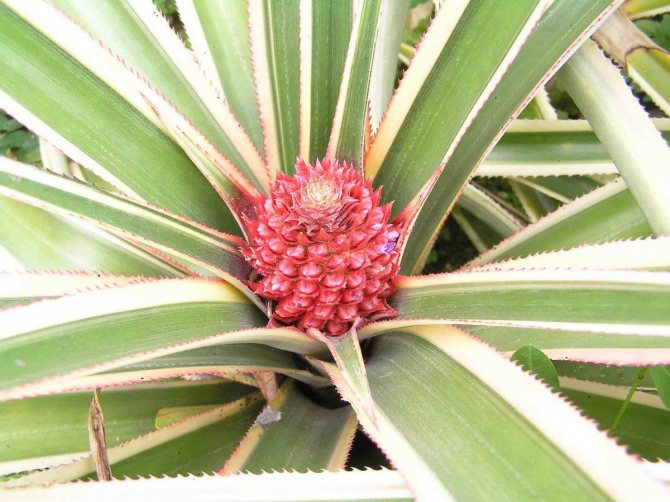

Flowering pineapple
Landing
How to plant a pineapple at home so that it soon pleases with fruiting? The pineapple top should be planted in light soil for indoor plants. The height of the planting container should be 15 cm:
- A layer of expanded clay and river sand is poured onto the surface of the bottom of the tank. Instead of expanded clay, a layer of perlite can be used.
- After the drainage layer, leaf or sod soil is filled up. You can also use commercially available soil, which is produced for cacti.
- It is necessary to make a depression in the soil into which the lower part of the stem is placed. The deepening is covered with a layer of soil. The main part of the rosette should remain on the surface and the stem should sit in the soil.
- The soil is abundantly moisturized. The upper part of the planting is covered with a plastic bottle (volume 5 l).
- The container should be placed in a warm and well-lit room. The soil should be moist, but not waterlogged.
- Seedlings need watering once a week. It is worth fertilizing every month.
- Flowering can be expected soon. A red cone is formed first, then blue flowers appear. From the moment of flowering until the fruit ripens, it should take about 5.5-6 months.
Planting pineapple
For planting a houseplant, a pot with a diameter of 14 cm is selected, a drainage layer is laid on the bottom. Acquire soil for palm plants. Sometimes they cook themselves: sand, humus, leafy earth equally. Previously, the earth is steamed or treated with a solution of potassium permanganate. Planted in moist soil, leave 2 cm to the edge of the container. Cover with foil.
After two months, rooting occurs. This time the ground is only sprayed. The formation of young leaves indicates that the plant has taken root. Old, dry ones are removed. The container is placed in a lighted place. Water so that there is water in the leaf funnel. Flowering is expected in two years.
What conditions are necessary for growing pineapple at home
Interesting Plant Facts:
- The homeland of the exotic fruit is the highlands of Brazil.
- The plant belongs to the Bromeliad family.
- In South America, under the hot sun, there are plantations with thousands of bushes, in the center of which rises a large oval fruit, covered with dense "scales", with a top ("tuft") of numerous leaves.
- In the tropics, the rosette near the main shoot sometimes reaches a diameter of 1.5–2 m, but at home the size is much more modest.
- In nature, pineapple develops two tiers of the root system: thin radial roots go deeper than 1 m. Closer to the surface is the second type of underground part. Roots often form in the leaf axils. Under natural conditions, they gradually lengthen, reach the ground, take root, and absorb additional nutrients.
- The height of the bushes is 70–80 cm, the root system is fibrous, surface type.
- On the main shoot, after flowering, an infertility with a keratinized skin is formed. Inside is a juicy, aromatic pulp of a pale yellow color.
- Leaves of the original, bluish shade.
- The fruits are consumed fresh and dried, frozen, prepared compotes, jams, base for liqueurs.
- Despite the fact that native spaces are located far in South America, pineapple grows successfully at home. The plant takes root quickly, a regular cut top is suitable for reproduction.
- After two to four years, with good care, flowers appear on the bush, the fruit ripens, covered with keratinized elements.
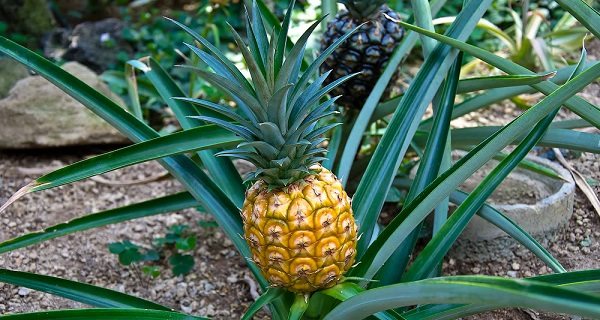

Optimal conditions for growing pineapple at home:
- temperature - from +22 to + 30 ° С;
- regular soil moistening;
- timely feeding with mineral fertilizers;
- good illumination (but not under the scorching sun);
- wide pot for placement of roots;
- moderate shading on hot days, supplementary lighting in winter;
- nutritious and loose soil;
- lack of drafts;
- gassed with ethylene to make the pineapple blossom and form an ovary.
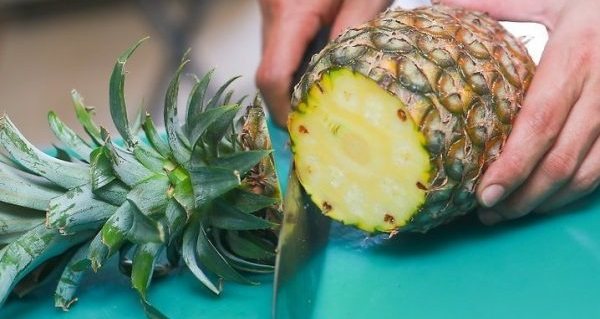

Pineapple care at home
Indoor conditions for cultivating pineapple create special care.
| Parameters | Spring Summer | Winter autumn |
| Temperature | + 22 ... + 25 ° С. | + 18 ... + 20 ° С. |
| Lighting | Bright, on the southeast windowsill. | Daylight hours up to 10 hours, additional lighting. |
| Watering | Abundant, after the soil has dried, warm water +30 ° C. | Moderate, once a week. |
| Spraying | Regular, warm showers. | Not required. |
| Fertilizers | Once every two weeks with an organic mixture or mullein infusion. | Not needed. |
Pineapple pruning is not required; with sharp scissors, periodically remove old, dried leaves without touching healthy tissues. A young plant is transplanted every year, and an adult - if the container has become small and the roots come out. This is done by the pass method.
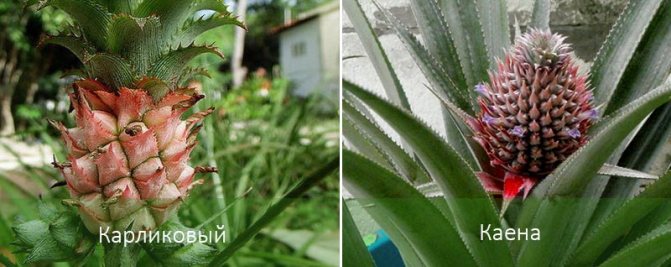

Germination conditions
As already mentioned, for the successful growth and development of pineapple, it is required to create conditions that are as close to natural as possible. To do this, it is recommended to pay attention to several basic indicators.
Lighting
It will take a lot of sun, so the sprout pot should be located on the south side of the room. Pineapple needs 6 hours of sun per day, and in the cold season you will have to take care of additional artificial lighting: the lamps must be turned on for 8 hours daily.
In the summer months, you can take the container out to the balcony or transport it to the country house, define it in the garden. The pot does not need to be rotated constantly so that the sun illuminates evenly parts of the bush. It is easy enough to install in one place.
Temperature
The presence of drafts and low temperatures, dampness - death for the plant. Therefore, in the warm period, room temperature and that outside the dwelling will be sufficient. But in winter, you cannot lower the temperature regime below +18 - 20 degrees.
Humidity
In the tropics, humidity levels are constantly high. Therefore, put the tub with the plant in a container with wet sand or expanded clay. But it is undesirable to spray the aerial part: rotting may begin.
The best place for good growth and maturation is in a greenhouse or bathroom that has a window and daylight sunshine.
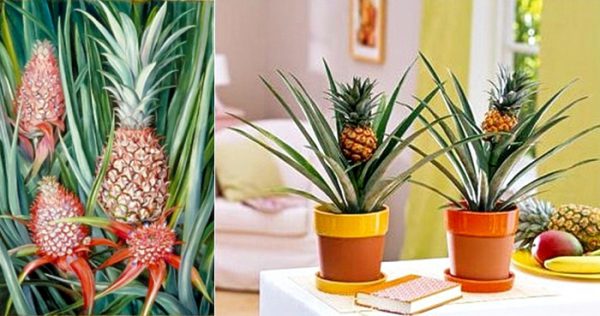

To prevent dust from accumulating on the surface of the leaves, periodically they need to be wiped with a damp sponge.
How to stimulate flowering
If, after several years, the plant does not bloom, the process is accelerated using calcium carbide, which releases ethylene. A tablespoon is insisted for a day in a sealed glass container, then filtered. The rosette of leaves is poured with the resulting solution of 50 grams for a week. After a month and a half, a peduncle usually appears. If the plant has not bloomed, it has not reached maturity.
Other ways - put a bag of apples in a bowl with pineapple or once a week make smoke: leave a smoldering paper nearby, a smoking cigarette, and cover the plant. Four procedures are done per month.
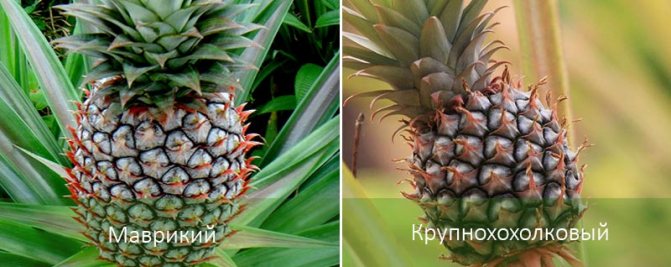

Maintenance and care
Since the homeland of pineapple is the tropics, it is accordingly accustomed to light, warmth and humid air. Pineapple tolerates drought stubbornly, and growing it in a room is not laborious and is quite within the power of everyone.
How to care for a decorative pineapple at home
Pineapple is a light-loving epiphyte, so it is best to place a pot with a plant on the south or southeast window, but even if your window sill is perfectly illuminated for about 12 hours a day, then being cold it can destroy the root system of the plant from hypothermia, because you can even water the pineapple only with very warm water. To prevent the roots from cooling, the pineapple pot can only be placed on an insulating substrate or insulated window sill, and it is safest not to place it at all on the window, but to install a flower stand or table next to the window.
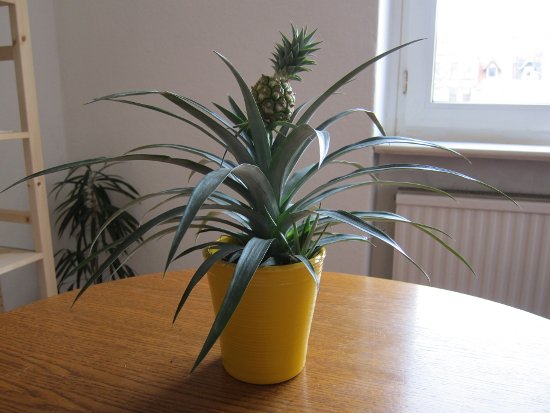

It is not worth placing a home pineapple too far from the window, it will lack light
Do not think that getting used to the tropics, pineapple will feel great in an apartment with central heating, it is not. This culture does not tolerate heat and dry air, therefore, it is necessary to maintain the air temperature during the day within the range of 22 ° -28 ° С, and at night it should not fall below 18 ° С.
What to feed and water
Pineapple should be watered only with warm or even hot water. Watering is necessary rarely, but abundantly and only after the earthen coma has completely dried.
During the period of active growth of pineapple from April to September, proper watering is a very important condition for keeping. Pineapples should be watered exclusively with warm or hot water, settled, and best of all, rainwater, which does not contain lime impurities. Watering should be rare, but abundant, and only when the soil is dry.
If the soil is not allowed to dry out, the roots of the plant will rot, and if the pineapple does not have enough moisture, its tips will dry out and the pineapple will begin to lose its decorative effect.
When watering pineapple, you can pour water from above so that it falls into the axils of the leaves and remains there. This moisture will serve as additional nutrition for the roots and ensure the well-being of the plant through evaporation.
Hooligan lovers will love watering the pineapple, as you can start doing it right from the top.
In addition to watering and leaf irrigation, pineapple will be grateful for the regular dusting of the leaves with a damp swab.
It is recommended to fertilize pineapple no more than twice a month and a mullein solution is considered an ideal feeding, which is infused in warm water for a day and then diluted 10 times. A liter of the resulting solution will last for a month and a half.
Mineral fertilizers for indoor plants or complex fertilizers for bromeliads are also good for pineapple, but the concentration of dressings should be half as much as according to the standard instructions.
After the pineapple has faded, it is worth feeding it mainly with nitrogen-containing agents for the rapid formation of the fruit.
How indoor pineapple blooms in a pot
The flowering times of home-grown pineapple tend to be unpredictable. About 3 years after planting the pineapple, the flowering period begins, which lasts about two weeks and is accompanied by a light aroma.
The bud forms at the very top of the central stem. Flowers can be bright blue, pink or purple, they can change their shade; are arranged in a spiral, open one after another and only for one day.
The pineapple bloom is inconspicuous and it is unlikely that they will be able to surprise anyone, but this process cannot fail to impress fans of exoticism.
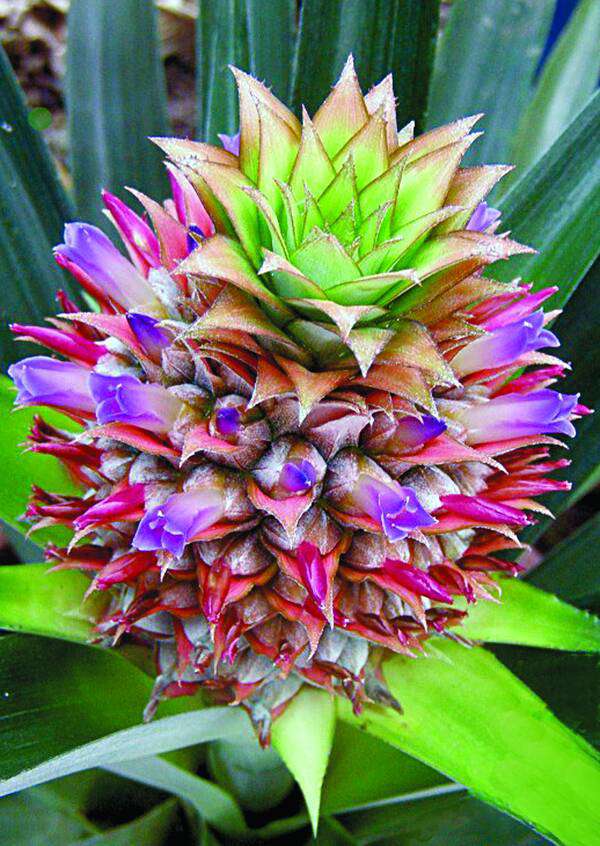

Pineapple blooms brightly, but very shortly
After flowering, the fruiting period begins, and small fruits are formed that are easy to root. It is worth noting that these rooted fruits will bloom even sooner than their parent.
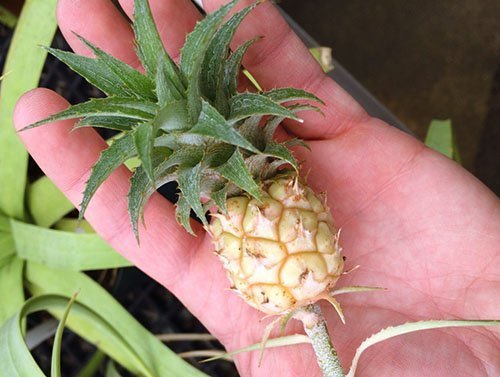

A small pineapple fruit is able to quickly take root and bloom before its parent.
One fetus left on the mother's socket can grow large enough. Its ripening period can be from three months to six months and depends on the pineapple variety and the conditions of its maintenance. The most favorable period for pineapple fruiting is summer.
After the fruiting stage, the pineapple dies. This is a normal natural process in the bromeliad family.
It happens that even with good care, the pineapple does not bloom. In such cases, you can make it bloom by artificial stimulation with ethylene gas. To do this, five grams of calcium carbide is dissolved in a half-liter container and infused for a day in a closed form. After that, the liquid is drained and only a sediment is left. This precipitate is the ethylene solution, which must be gradually placed in the core of the pineapple rosette over the course of a week. A month or one and a half after such stimulation, the plant should enter the flowering phase.
Video: flowering and growing pineapple at home
Pineapple hibernation
In winter, pineapple hibernates, but this does not mean at all that it does not need to be watered. Watering pineapple should be moderate. One abundant watering per week or two waterings per week will be enough, but a smaller amount. The soil should not be wet all the time, since the dormant period for pineapple passes at a temperature of about 15 ° C, and at low temperatures, the bay can turn into decay of roots or rosettes.
Top dressing is not carried out until March-April and the lighting will also have to be slightly reduced, as well as the temperature, otherwise the pineapple will not fall asleep and will suffer from a lack of nutrition and heat.
In the spring, the pineapple will gradually wake up on its own: new leaves will begin to appear. If awakening does not occur, it is necessary to increase the amount of light and transplant the plant into new soil.
If you want pineapple to stay awake in winter, it is important to provide the plant with additional lighting (at least 10 hours a day) and maintain an average temperature of 22 ° C-23 ° C. In addition, you should continue to feed the pineapple at least once a month.
Reproduction of indoor pineapple
After fruiting, the plant dies, this can happen after a few years. During this time, lateral processes are formed, they are seated separately. They bloom before the top. Cut off or break off the shoots from the mother's outlet when they grow up to 20 cm. Sprinkle the cuts with wood ash. After drying, they are planted.
For the soil, a layer-by-layer option is recommended: sod soil, leaf humus, river sand. Soil temperature + 24 ° С. After planting, they are covered so that the film does not touch the leaves (for this, they put supports).
Seeds are not an easy way to reproduce. First, they are removed from the ripe pulp. Suitable for germination is a semicircular seed 3-4 cm long, brown or reddish. Washed in manganese, dried. For a day, put on a damp napkin, cover the second, put in a warm place for germination. Sow into the ground from leafy earth, peat and sand taken equally by 1.5 cm. Cover with foil. The light is provided by bright, the air is warm and humid, watering is regular.Ventilate systematically. Seeds sprout for a long time, from 2 to 6 months. After the emergence of shoots and the formation of the third leaf, fertilize with bird droppings (a teaspoon per liter of water). They dive when they reach 6 cm in height.
Diseases, pests and possible problems
When growing exotic plants, problems can arise. The most common are:
- Drying of the tips of the foliage. Occurs against a background of too dry air. To cope with the problem, it is necessary to raise the humidity level.
- Mold in a pot occurs against the background of frequent soil moistening procedures in the cold season. In this case, the mold is removed, and the frequency of watering is reduced.
- Root decay is most common when grown in a humid room. In this situation, it is important to trim the bottom of the trunk down to healthy tissue. At the same time, the apex takes root.
- Slow growth. To accelerate growth, you will need to move the pineapple pots to a warm room.
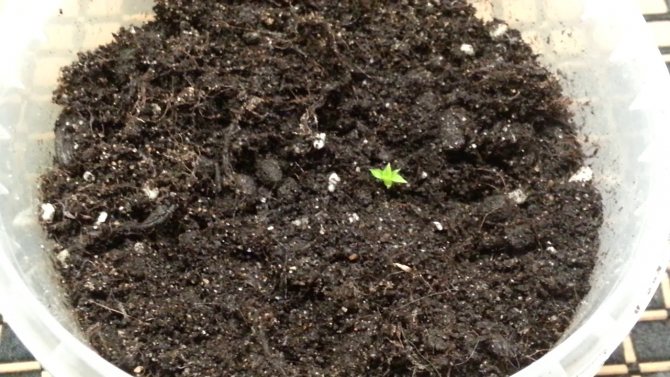

Growing a herbaceous crop from seeds
Note! Exotic culture is not susceptible to pest infestation.
Growing pineapple from seeds at home
The seed method is the most laborious and complex. It should be borne in mind that seedlings will appear only from purchased seeds. From those seeds that were found in purchased fruits, pineapples will not germinate.
The seed that will sprout is naturally endowed with a simplified semicircular shape and is colored in brown tones. Its length reaches 4 mm.
- Before planting, the seed is placed in a damp cloth for a couple of days and transferred to a warm room.
- After the seeds have swollen, it is worth preparing a container filled with a mixture of peat and sand.
- Seeds are sown in a container with a substrate.
- The soil is moistened, and the container is covered with glass. The seed pots are transferred to a warm room.
- Seedlings can be expected after 4-7 weeks.
- It is very important that during this period the temperature in the room is in the range of 25-27 degrees. The soil should be moistened every 3 days.
- From 3 weeks after planting the seeds, it is necessary to make complex fertilizing.
- As soon as the second pair of foliage is formed on the sprouts, the seedlings can be cut into separate containers. For planting, it is worth using a soil mixture, which includes a small part of humus, perlite, peat, garden soil and sand. The soil is mixed with charcoal (5%).
Note! You can expect the first fruiting after a couple of years.
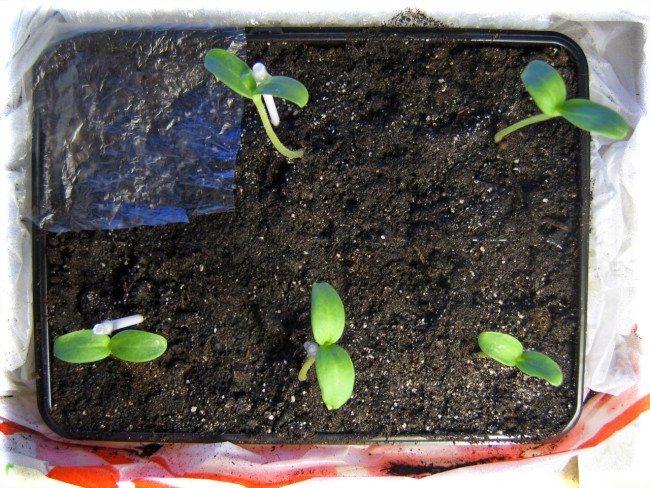

Perennial seedlings
Diseases, pests, problems in the care of indoor pineapple
Pests hardly attack the plant if all care conditions are met:
| Problem | Cause | Elimination |
| Slow growth. | Cold air in the room. | Rearranged in a warm place, watered with heated water. |
| The root system is rotting. | High humidity and cold. | Reduce watering, treat the soil with a solution of karbofos. |
| The tips of the leaves dry out. | Low humidity. | Spray more often, put humidifiers. |
| Mold on the walls of the pot and in the soil. | Abundant watering in winter. | Remove mold, reduce watering. |
| Light spots on the leaves. | The pest is a false shield. | Treated with a solution of potassium permanganate. |
| White discharge on leaves, slow growth. | Mealybug. | Spray with soapy water. |
| Yellowing, falling foliage. | Aphid. | They are processed with Aktellik. |
| Spider web on the leaves. | Spider mite. | Apply insecticides. |
What problems can you face
If you notice rot at the base, curled or brown leaves, pale or dry, poor growth and no flowering period, then there is illness or improper care. You need to go to a flower shop and purchase a product, take action as soon as possible.
Diseases and pests
- Shield (sap) causes brown spots. Insecticides, soap solution will help.
- Mealybug (feeds on juice, envelops the plant with a white bloom).Apply soap solution, drugs "Actellik", "Karbofos".
- Root worm (destroys roots, looks like mold). The roots are immersed in water (temperature +55), then disinfected with "Actaricide", transplanted.
- Spider mite, orchid aphid (feed on juice). Soap solution, onion or "Appolo", "Karbofos", "Actellik" will help.
- Fungus. Appears after nitrogen-containing fertilizers. Fungicides are used.
Is it possible to grow in a vegetable garden in Ukraine
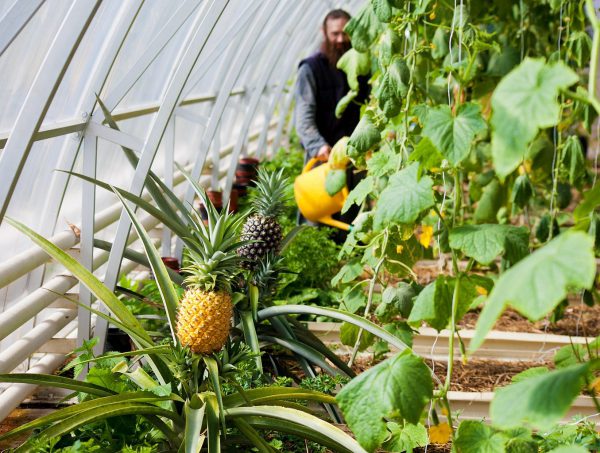

Only a greenhouse or room will do.
In an open place, without shelter, it is impossible to do this. The climate in any part of the country is too cold in winter, autumn and early spring for pineapple cultivation.

